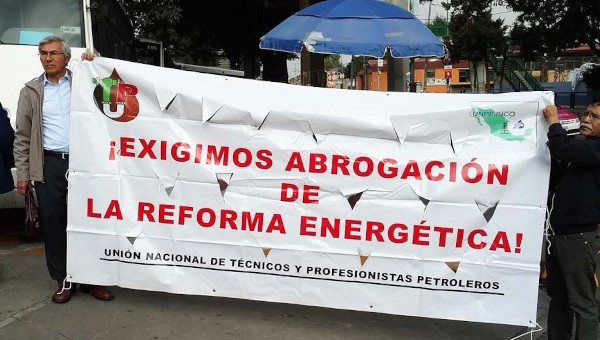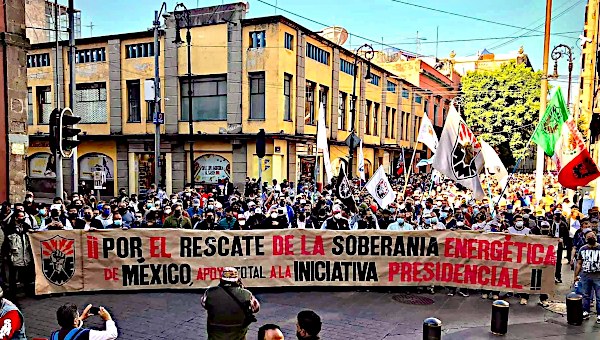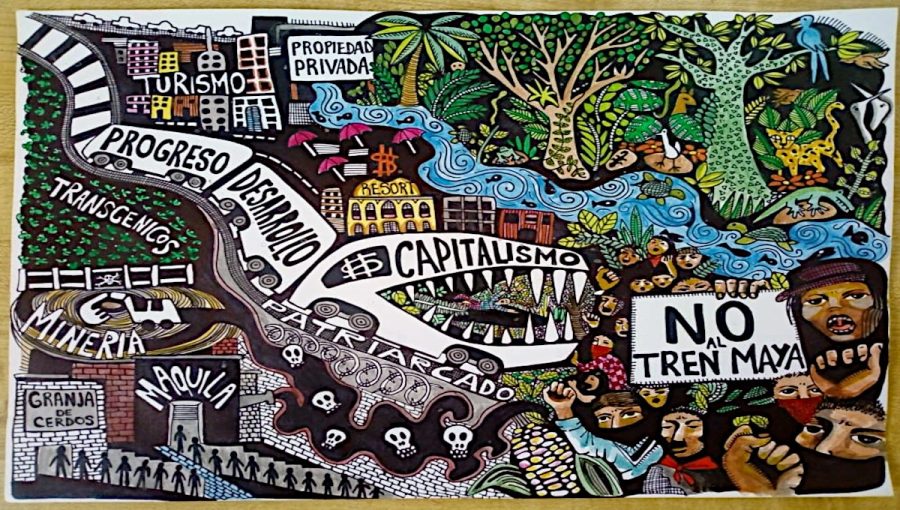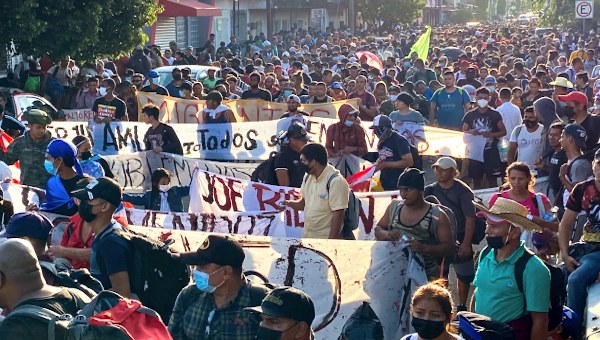Maxico part 2: The Fightback
Mexico: The Murder of a Union and the Rebirth of Class Struggle
The Fightback: From Protest to Rebellion?
The government’s blitzkrieg attack on the SME has failed to destroy the resistance. Rather, the Mexican regime faces the broadest, deepest, and most unified resistance movement in decades. And, as importantly, it is a national resistance movement that is working-class centered – in its leadership, central issues, and symbols. The government has not been able to destroy the SME or the popular resistance. While the fight back has been growing, it does not have the strength to force a quick reversal of the government’s actions. A reversal by the government would stall the neoliberal project, alienate its already restless big business backers, and deepen the regime’s vulnerability. If the SME loses, this 95 year old democratic union will have been “disappeared” along with all the jobs, benefits and rights held by its members and retirees. And every other union or popular movement would know more clearly that its very existence is contingent on the whims and policies of the political elites and big business. There is a “catastrophic equilibrium,” a stalemate without any clear avenue of compromise or of a negotiated way out.
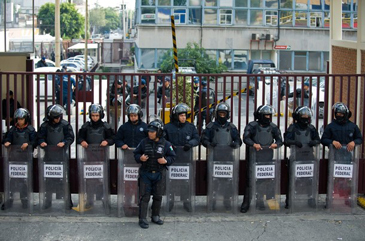 The anger and despair built on decades of massive cuts in real wages as well as to the very limited social net that existed for some sectors is now being intensified by the deep economic crisis of Mexico. The safety valve of jobs in the U.S. for millions of “excess” Mexican workers has been significantly reduced due to the U.S. economic crisis. Remittances which have supported many families and communities in Mexico have sharply declined. As well, the global economic crisis and swine flu have led to a great decline in jobs and income from tourism and Mexican oil income, which provides 40% of the Federal budget, has fallen with the decline in oil prices. And Mexico’s dependence on exports to the U.S. – 80% of Mexico’s exports go to the U.S., much of it as part of an integrated production process of the large corporations – has caused a sharp decline in employment in the maquila sector. Mexico’s decades-long neoliberal restructuring and deliberate depression of wages and working conditions has now been compounded by the sudden and deep global economic crisis.
The anger and despair built on decades of massive cuts in real wages as well as to the very limited social net that existed for some sectors is now being intensified by the deep economic crisis of Mexico. The safety valve of jobs in the U.S. for millions of “excess” Mexican workers has been significantly reduced due to the U.S. economic crisis. Remittances which have supported many families and communities in Mexico have sharply declined. As well, the global economic crisis and swine flu have led to a great decline in jobs and income from tourism and Mexican oil income, which provides 40% of the Federal budget, has fallen with the decline in oil prices. And Mexico’s dependence on exports to the U.S. – 80% of Mexico’s exports go to the U.S., much of it as part of an integrated production process of the large corporations – has caused a sharp decline in employment in the maquila sector. Mexico’s decades-long neoliberal restructuring and deliberate depression of wages and working conditions has now been compounded by the sudden and deep global economic crisis.
The depression itself has restructured the labour market downward within Mexico and for Mexicans working abroad. But the big bourgeoisie in Mexico, as throughout the world, is seeking to use the crisis as a rationale for a further radical downward restructuring of the labour market. The Mexican government’s new budget is an austerity budget with massive cuts to public spending and increases in regressive taxation against workers and the popular classes. The fiscal class war became more public when López Obrador and the PRD members of Congress pointed out that the largest corporations in Mexico pay no taxes while the government seeks to impose even more of the tax burden on working people.
There has also been growing anger in communities over frequent blackouts, some that last for days, as a result of the inability of the government to keep the power company functioning without the expertise of workers who had long managed to keep a constantly and deliberately underfunded public utility running. Management and scabs have not been able to keep the power supply flowing and there have been spontaneous protests of various communities at the frequent blackouts. The government has tried to blame these problems on sabotage but all the workplaces are under military and police control.
Community anger is also likely to increase sharply when people begin to experience higher power costs to go along with poorer and less reliable service. The recent federal budget does not include any money for the LyFC nor does it include any extra money for the CFE, (the other public power company), the company that is slated to take over the jurisdiction of the LyFC (probably as a prelude to privatization by stealth or direct privatization). Most of the budget for the LyFC went to subsidize cheap power for consumers and business, with consumers paying only one-third to one-half of the real costs of energy production and distribution. This subsidy has been slyly eliminated along with the LyFC and residential consumers will certainly have to pay higher rates. What business sectors will also have to pay to make up the gap remains to be seen but if past and recent policy is a guide, big business will be spared the burden.
All of these factors – the effects of the deteriorating economy, the anger at regressive taxes, the frustration with frequent power failures in central Mexico, the coming increase in utilities bills, the general inflation of basic goods, and the little legitimacy of the President, are producing propitious conditions for a breakthrough in workers’ militancy. The challenge for the SME and for the movement of popular resistance is to create a viable strategy and program, one that provides understandings, hope, and direction for the growing anger and despair and can offset the systematic attempts of the capitalist media and the state to promote fatalism and individualism.
The SME itself can no longer act simply as a union. There is no path to regaining their collective rights without a change in the correlation of forces at the national level. While the SME is pursuing all forms of legal challenges, there is little optimism that court decisions will prevail in the end. The SME has been forced to become a political movement that, in addition to developing its strategy and tactics with its allies, has to redefine its own identity as an organization/movement. It cannot survive without transforming itself and the government, if not the whole power structure of Mexico.
The attempt of the government and the capitalist class to break the solidarity and combativeness of the SME has failed so far. The malicious and dishonest propaganda campaign against the workers carried out by both government and corporate media, the insistence on the irreversibility of the liquidation, the attempt to play on and sow new divisions in the union, the offering of special bonuses for accepting severance by November 14, the cutting off of medical care, the promise to SME pensioners that their pensions and benefits would not change, have all been in the service of dividing and demoralizing the SME. But the union now has greater solidarity than ever.
The pensioners have denounced the government’s offer and are continuing to battle alongside their SME brothers and sisters. On November 23, eleven female electricistas, some of them mothers, started an open-ended hunger strike outside the CFE headquarters in Mexico City and SME members have also started another hunger strike in Pachuca, Hidalgo. Two-thirds of the members employed at the time of liquidation have filed one or more legal actions against the government. Though around 50% of the workers accepted the severance money, many have said they did so under the coercion of economic hardship as well as threats and have challenged the legality of the whole process. The union has taken a compassionate position toward those who took the payout and many, if not most of them, continue as union members to battle against the whole process. Small farmers have already sent tons of corn, rice and beans to the SME. The PRD (Partido de la Revolución Democrática – Party of the Democratic Revolution) and members of the legislative assembly of the Distrito Federal (core part of Mexico City) have donated funds to the SME. After six weeks of resistance – with no strike fund and with the government having cut off all access to the union’s own funds – the movement is holding solid with growing support from other sectors. The SME union/movement has survived the blitzkrieg attack and is preparing for a long battle.
The SME has often been the organizer and fulcrum of broad fronts of class resistance, such as the Dialogo Nacional, started in 2004. The Dialogo Nacional has been a space for gathering the various forces of the opposition to neoliberalism together – the democratic union movement, popular organizations, and the left – to discuss an alternative vision to that of neoliberalism. It has not been an organizational structure but a once a year space for discussing and articulating a vision and ideas of struggle. It was, as one militant described it, a space with a fever of ideas and programs and a paucity of common organization and action. But the new situation demands more than ever that the national movement of popular resistance transform itself to an effective fighting organization or face annihilation.
The room for talk and symbolic protests has disappeared. The SME and National Front of Popular Resistance must deepen and spread militancy and class consciousness to wider circles of workers and more regions or be defeated. These processes of agitation and organization will necessarily develop unevenly and their outcome is uncertain. But it is essential for any effective challenge to the regime. For while Mexico City and the traditional strongholds of the left have a basis for a “war of maneuver,” for a quick and intense fight-back, the movement of resistance does not have that immediate potential in other areas of the country, most significantly in the key industrial zone of the state of Mexico, still Mexico’s most important industrial zone, and in the other industrial zones, which remain under the joint control of PAN or PRI state governments and charro unions. The systematic attempt by the main television networks, newspapers and the government, to portray the SME workers as privileged, inefficient, selfish and the union as corrupt, have to be overcome. These deliberate attempts to divide and confuse the working class have to be combated ideologically to build working class solidarity. The resistance movement has shown its awareness of this issue by making the two major television networks targets on their November 11 day of protest.
There have now been two national assemblies of popular resistance as well as escalating mass mobilizations involving wide sectors of the population. While workers are at the core of the resistance either through their unions or through currents inside charro unions, there is widespread and active participation from other organizations and sectors – campesino organizations, the APPO (Asamblea Popular de los Pueblos de Oaxaca), students, intellectuals, popular movements, segments of “The Other Campaign,” and left parties and groupings. A total of 700 organizations supported the November 11 paro civico nacional (national civic strike).
The November 11 paro civico nacional saw significant actions in at least 22 of Mexico’s 31 states. The strongest actions were in Mexico City and in those surrounding states where the liquidated power company and the SME have a presence. As well, there were strong protests in traditional strongholds of the left where the SME has no presence, e.g. Oaxaca, Michoacán, and Chiapas. The teachers in the states of Oaxaca and Michoacán shut down almost all the schools in both states. These sections of the national teachers union are part of the CNTE (Coordinadora Nacional de Trabajadores de Educación), an organized national alliance of dissident teachers’ groups in the SNTE (the national teachers union), a gangster-charro union with close to 1.5 million members. In Oaxaca, Section 22 of the teachers union and APPO closed down all the facilities of the CFE, the national power company which has a charro union and is being substituted for the LyFC. Many sections of the SNTMM (Sindicato Nacional de Trabajadores Mineros, Metalúrgicos y Similares de la República Mexicana), the miners and steelworkers union, shut down workplaces for brief periods. (The SNTMM itself has been severely persecuted by the government and its president is in exile in Canada.) The spread and variety of the actions make it hard to calculate the number of people that participated. The SME estimates that 5 million people participated nationally; a more cautious estimate might be 3 million. Nevertheless, November 11 indicates a greater national extension of the protest movement.
The SME along with the PRD and the López Obrador movement are promoting a mass consumer campaign to refuse payment of electric utility bills. They argue that consumers have no contract with the replacement company, the CFE, though the government has announced that bills will now come from the CFE. This campaign to develop consumer solidarity with the workers could gain great traction as it meshes with the growing anger about blackouts. This campaign unites the workers’ concerns for their jobs and rights with the concerns of consumers, most of them workers themselves, for an adequate and affordable public service. As well it brings together the struggle for union rights with the López Obrador movement against electoral fraud and for the preservation of public ownership of energy.
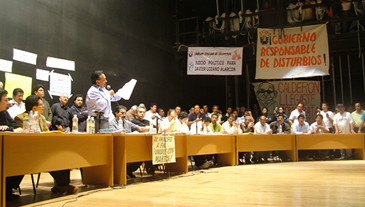
The resistance has described the November 11 actions as a prelude to a general strike. An effective general strike will have to spread to areas outside the traditional strongholds of the Left to include key industrial locations. Most of these industrial areas are controlled by regime-linked gangster unions, often with protection contracts. An effective general strike would need to penetrate these areas that are walled off by authoritarian state governments and their gangster “union” allies.
The expansion of the movement to industrial sectors of the working class and other regions is as difficult as it is necessary. It will not be an easy or quick effort. It will take a daring political strategy and courage to overcome the tremendous obstacles that have led to failures in the past. The workers’ movement and the Left have had brief moments of massive national fronts of struggle that have been defeated by repression and internal divisions. In some of these attempts, as pointed out by Luis Hernández Navarro, “the logic of the immediate struggle of the sector with the greatest political force has ended up dominating and absorbing the demands of its allies. And the worry of being used as a maneuvering mass by other political actors and their electoral and parliamentary agenda continues weighing on the diverse social actors.” (Luis Hernández Navarro, “La Asamblea Nacional de Resistencia Popular,” La Jornada, Oct. 27, 2009). As well, a narrow trade union agenda of a strong component organization could be added, as is clear from the examples Hernández Navarro gives earlier in his column. The challenge for the Left is to develop a program and process that helps protect the movement from this danger pointed out by Hernández Navarro. But it should also be noted that dividing off part of the movement by concessions or electoral hopes involves an ability and a willingness to make concessions and an ability and a willingness to conduct (somewhat non-fraudulent) elections. Neither of these options seems likely in the present context and certainly is not possible in regard to the power workers without a big defeat for the government. The danger that Hernández Navarro points to is real but is more of a danger in normal times. Mexico is in a profound crisis of legitimacy and a deep economic crisis.
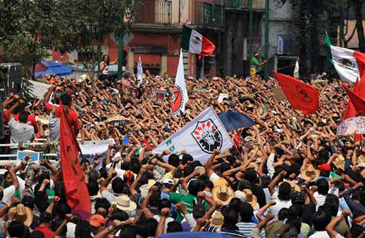
The movements that compose the national front of resistance are politically heterogeneous. While some have revolutionary perspectives, most have reformist perspectives, often with a hope or nostalgia for the real or imagined good old days of revolutionary nationalism. But there is a broad recognition that a change of direction is not possible without a change in the correlation of forces at the national level. This means defeating the PAN/PRI coalition that acts in the interests of Big Capital. As the government has slammed the door more and more on channels for redress and reform within the system, non-revolutionary movements are being driven toward direct action as the only way to reverse the recent actions and change the direction. It has become more clear to many that only the removal of the government could lead to free, honest and democratic elections. Some feel that a constitutional convention would also be a necessity.
The efficacy of a general strike depends on its strength, both in its immediate execution and its ability to achieve its goals. An inadequately prepared or weak general strike is a potential disaster for the workers’ movement and the Left as the government will respond ferociously, unless its hand is stayed by the power of the movement. The SME and the resistance movement are organizing brigades of workers to build support for a general strike nationally. The challenges are huge but there’s no alternative to a national struggle to change the power balance within Mexico. The fact that a workers organization is at the organizational and symbolic center of a growing movement of popular resistance is a sea change with enormous implications.
The student revolt of 1968 and its crushing defeat had great repercussions for Mexico, leading to guerrilla movements and a liberalization of the political system. The 1987-1988 neocardenista mass electoral and then anti-fraud movement set into motion new layers of activists despite its subsequent corrosion and distortion by electoral instrumentalism. The 1994 Zapatista uprising created great hopes and encouraged new layers of activists and despite its subsequent political isolation, its inspiration continues to influence many indigenous and poor communities with the belief that another world is possible. The 2006 electoral and post-electoral anti-fraud mass mobilizations deepened the challenges to the legitimacy of the regime and also brought into action new layers of people, many of them working class. And now the devastation of neoliberal austerity, the economic crisis, and the lightning assault on the SME (and Mexican energy resources) have mobilized large layers of the population into renewed activity. Mexico could follow the paths of Bolivia and Ecuador where revolts from below overthrew governments and paved the way for honest elections and the triumph of the Left. Or it could continue to go in the direction of Colombia, to an increasingly repressive and authoritarian narco-state. With its vast common border with the U.S. and one in every five Mexican workers living and working in the U.S., the implications are enormous not only for Mexico but also for the USA. •
Resources
- David Carrizales and Roberto González Amador, “El Banco Mundial considera prueba de “madurez política’ el aumento de impuestos,” La Jornada, November 9, 2009.
- Luis Hernández Navarro, “La Asamblea Nacional de Resistencia Popular,” La Jornada, Oct. 27, 2009
- Office of Public Affairs, U.S. Department of Justice. “Former General Manager of Texas Business Arrested for Role in Alleged Scheme to Bribe Officials at Mexican State-Owned Electrical Utility.”
- Richard Roman & Edur Velasco Arregui, “The Oaxaca Uprising: Implications for Mexico,” in Socialist Register 2008: Global Flashpoints – Reactions to Imperialism and Neoliberalism, edited by Leo Panitch and Colin Leys. New York: Monthly Review Press, 2008; also available as “The Mexican Crisis and the Oaxaca Commune.”


